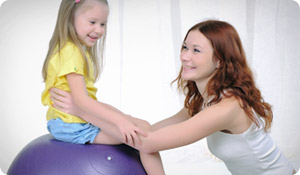
Winter may be well underway but that doesn't mean your family has to stay cooped up inside in front of the TV.
In 2008, the United States Department of Health and Human Services (HHS) established guidelines. For children age 6 and up and adolescents, one hour or more of moderate or vigorous aerobic physical activity a day, including vigorous intensity physical activity at least three days a week are recommended by the HHS.
Teri McCambridge MD, chairperson of the Council of Sports Medicine and Fitness for the American Academy of Pediatrics admits this may sound like a lot but the government's recommendation is not for continuous activity but 60 minutes of total physical activity during the day.
"So, if you walk to and from school 10 minutes each way and then do some sit-ups and push-ups, ride a stationary bike, work in another 20 minutes walking the dog or playing Wii Fit, the time adds up quickly," McCambridge says.
Say No to Cabin Fever and Get Moving
Adopt these active ideas from Dr. McCambridge and the National Strength and Conditioning Association (NSCA).
1. Turn on TV, exercise TV that is. TV isn't all bad. Cable television offers a wide variety of workouts—many of them free—some even geared to children. Make it a family affair by having the kids look at the options and select a workout to do together.
2. Set a good example. When children see a parent get physical it sends the message that exercise is important.
3. Play inside. Look around your house—or in your garage. You likely have items that can be brought indoors. Balloons, hula hoops, jump ropes, resistance bands, Nerf or other soft balls, light weights and bean bags can all get the heart rate pumping.
- No weights? Substitute canned veggies or fill an empty gallon of milk with water.
- Balloon volleyball is great fun when played across a threshold.
- A yoga mat can easily be converted into a hopscotch board. Use spare change and get hopping.
- If you watch TV as a family, take turns jumping rope during the commercial breaks. See how many times you can jump in one minute (aim for 100).
- Or turn on some music and dance or do jumping jacks through the ads.
4. Pick a fight. Divide the family into teams and have a good, old-fashioned pillow fight. "Not all exercise has to be work," says Dr. McCambridge. "The goal is to raise the heart rate and get up out of the chair." Speaking of pillows...
5. Over and under. It's easy to make an indoor obstacle course with bedding and couch cushions. Set the kitchen timer and turn it into a race.
6. Be your own stair master. Step right up, and down, the steps in your home. If you have a staircase, you have a cardio workout opportunity.
7. Take a seat. Chair squats strengthen legs and abdominal muscles, too. Most fitness instructors recommend repeating strength-training exercises several times in a row. Do 8 to 15 reps. As strength improves, aim for 10 sets of 10 to 15 reps resting a few seconds between each round.
Dr. McCambridge says starting weights after 8 or 9 years of age is safe. "Go for low weights and high repetitions. What's critical for safety is parental supervision." Not sure if a weight is too heavy for your son or daughter? If your child can't do more than eight reps easily, go down a pound or two.
8. Step out on the town. When winter ice makes walking hazardous, consider the local mall (yours may be open to the public for exercise before or after store hours) or using an indoor track at a nearby community college.
Can't drum up interest in a walk? Pedometers are inexpensive and might make the activity more appealing to your little complainers.
9. Mom vs. teen. Designate someone in your family to make a chart and track the amount of time each family member spends exercising. At the end of the week, "crown" the winner Fitness King or Queen.
10. Take it indoors. Sports like bowling and ice skating are obvious choices in bad weather but what about indoor climbing spaces or open gym night at the local community center?
11. Let it snow. Have a vigorous family snowball fight. Go sledding in the backyard or a local park or just admire winter's snowy beauty with a brisk family walk through the neighborhood.
Sources:
The Centers for Disease Control and Prevention
http://www.cdc.gov/physicalactivity/everyone/guidelines/children.html
Interview with Teri McCambridge, MD; Chairperson Council of Sports Medicine and Fitness for the American Academy of Pediatrics. Assistant Professor of Pediatrics at the Johns Hopkins School of Medicine
National Strength and Conditioning Association (NSCA)
http://www.nsca-lift.org/Press/
The U.S. Department of Health and Human Services guidelines for physical activity
http://www.health.gov/paguidelines/guidelines/default.aspx





